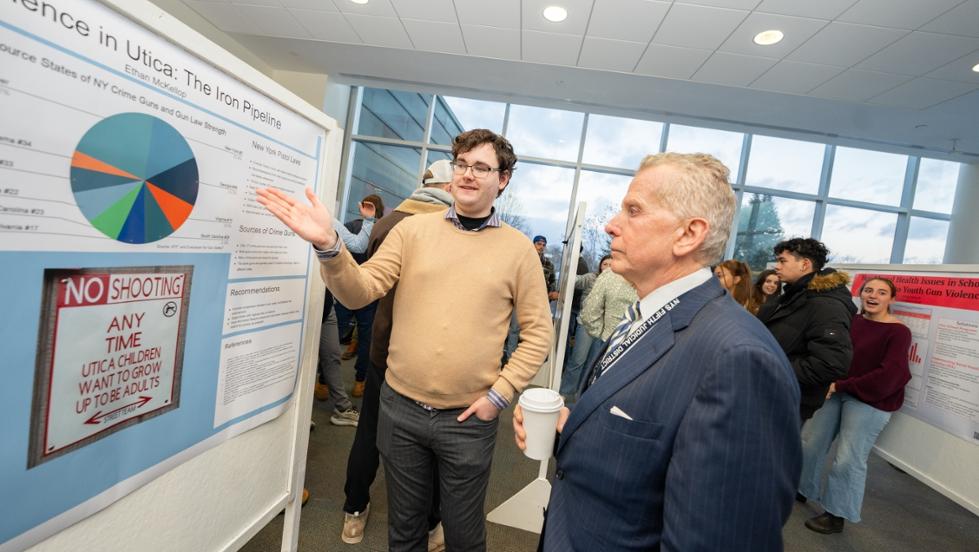
The Justice Lab was conceived following a February 2024 meeting between Levitt Center staff, Utica Mayor Michael Galime, and Chief of Staff Michael Gentile, during which the need for an in-depth assessment of the city’s youth gun violence was discussed. Government Professor Frank Anechiarico, Philosophy Professor Marianne Janack, Visiting Professor Jeffrey McArn, and retired Judge Ralph Eannace presented four distinct courses. They also directed students in extensive research, including interviews with local law enforcement, judicial officials, probation officers, and community members.
Each of the 16 students researched and wrote reports on various aspects of the gun control issue from Social and Economic Mobility to Student Mental Health to Juvenile Justice and Ghost Guns. They also analyzed data from a public opinion survey conducted by Hamilton in collaboration with Colgate University’s Upstate Institute and Zogby Analytics.
The final report identifies key factors contributing to youth gun violence in Utica, including economic hardship, deindustrialization, residential segregation, and intergenerational trauma. It offers a series of recommendations across five strategic areas briefly summarized here:
Economic and Community-Based Interventions:
- Revive gun violence prevention grants and provide at-risk youth with employment opportunities.
- Implement a Neighborhood Investment Fund, modeled after Chicago’s Neighborhood Opportunity Fund, to support businesses in high-crime areas.
- Strengthen violence interruption programs to mediate conflicts and offer social support.
Law Enforcement and Enhanced Community Policing:
- Enhance community policing strategies to improve cooperation and crime reporting.
- Provide restorative justice and trauma-informed training for police officers and employ that training to prevent excessive force incidents.
- Establish a police-community trust initiative to facilitate open dialogue particularly in high-crime neighborhoods.
Criminal Justice System Reforms:
- Expand alternative sentencing programs.
- Increase access to Teen Accountability Courts.
- Implement community-based interventions.
- Address racial disparities in gun-related sentencing.
- Enhance reentry programs for formerly incarcerated youth.
- Implement implicit bias training for law enforcement and court officials.
Tracking and Regulation of Guns:
- Disrupt gun trafficking networks and enhance gun tracking technologies.
- Expand community-based interventions.
- Focus law enforcement efforts on disrupting illegal firearm supply chains.
- Prioritize preventive measures to steer at-risk youth away from gun-related crime.
- Foster collaboration between policymakers, law enforcement, and community leaders for a holistic response.
Education and School Policy Reforms:
- Establish permanent School Resource Officers trained in adolescent mental health and conflict resolution.
- Shift from exclusionary discipline to restorative justice programs.
- Enhance mentorship programs, alternative education models, and early childhood education to support at-risk students.
- Strengthen community collaboration and support services.
Utica Mayor Michael P. Galime commented, “The Utica Police Department prides itself on our accreditation standards, training, and use of bleeding edge technology. This is reflected in how our officers interact with and protect our community. As always, the body of work provided by Hamilton College and the Levitt Center for Public Affairs is an example of their work proving its worth in leading our city into the future. With respect to this report, we have added confidence that the direct police work we perform, and the collaborative efforts we undertake to mitigate youth gun violence indirectly through outreach and community involvement are making a difference – with the added benefit of reflecting on how we can iteratively improve our efforts in serving the City.”
Youth Gun Violence in Utica, New York: Causes, Context, and Prevention
This report is the culmination of the Center’s Fall 2024 Justice Lab, an interdisciplinary initiative involving 16 students across four integrated courses led by four Hamilton faculty members.
Posted April 22, 2025


